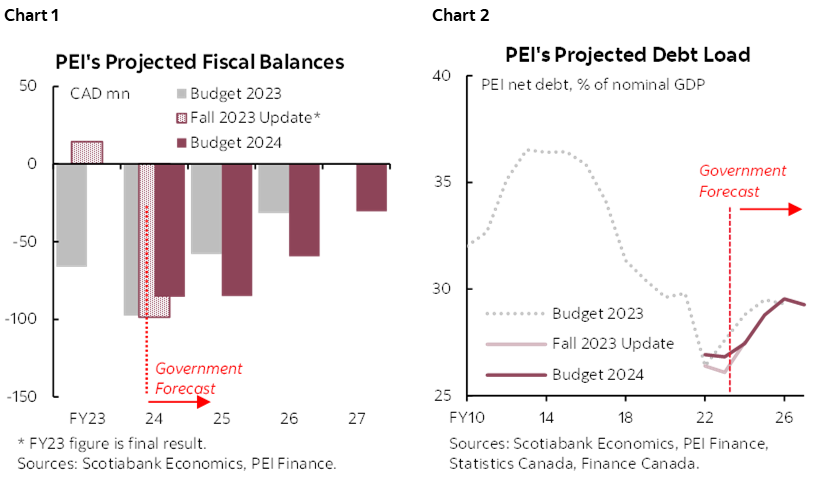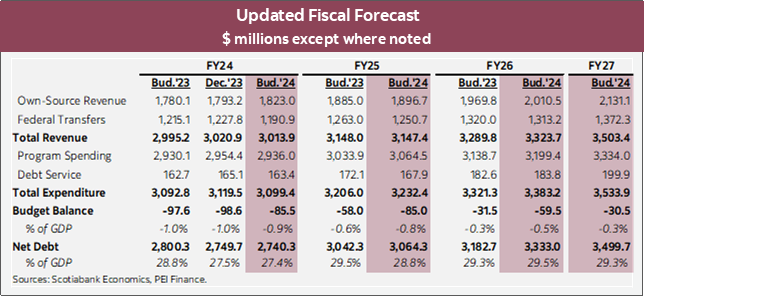TIMELINE FOR DECLINING DEFICITS IS PUSHED OUT
- Budget balance forecasts: -$85.5 mn (-0.9% of nominal GDP) in FY24, little changed at -$85.0 mn (-0.8%) in FY25, then -$59.5 mn (-0.5%) in FY26, and -$30.5 (-0.3%) in FY27 (chart 1).
- Net debt-to-GDP: 27.4% of nominal GDP in FY24, 28.8% in FY25, 29.5% in FY26, and 29.3% in FY27 (chart 2).
- Real GDP forecasts: 3.0% in 2023, 4.1% in 2024, and 4.0% in 2025.
- Borrowing program: $531 mn cash requirements, up 35% from the prior fiscal year, of which $400 mn is long-term borrowing.
- Changes to personal income tax brackets and the carbon levy along with additional spending on healthcare, public education, and housing result in a longer and slower decline in deficits amid forecast assumptions of steady economic growth.

OUR TAKE
Budget 2024 presents a smaller deficit for PEI’s FY24 than the mid-year update but bigger deficits that will steadily decline through the forecast horizon. The budget balance for FY24 is expected to be -$85.5 mn (-0.9% of nominal GDP), an improvement of $13.5 mn relative to the December 2023 update owing to lower program spending. The fiscal balance path is projected to be little changed in the year ahead. Running a deficit of $85 mn (-0.8% of nominal GDP) in FY25 that will steadily decline to $59.5 mn (-0.5%) in FY26 and $30.5 mn (-0.3%) in FY27, the budget pushes back the planned decline in deficits by a year.
Total revenue in FY25 is expected to increase by $133.5 mn to $3,147 mn in FY25, up 4.4% year-over-year. Of this increase in total revenue, nearly half is expected to come from federal transfers (+$60 mn) owing primarily due to greater equalization payments (+$48 mn), in addition to infrastructure programs (+$14 mn) and health transfers (+$4 mn) from the government of Canada. The remainder of the province’s increased revenue is expected to come from own sources. Personal income taxes in FY25 is expected to increase by $39 mn to $594 mn (7.1% y/y), while the announced raise in tax bracket thresholds and lower tax rates for the first four tax brackets take effect January 2025. Rising corporate income taxes (+$29 mn, 21.8% y/y), sales tax (+$8.3 mn, 1.6% y/y) and real property tax (+$8.2 mn, 5.3% y/y) are partially offset by a reduced carbon levy (-$8.8 mn, -85.5% y/y).
Total expenditure adds on an additional $26.4 mn of spending in FY25 and $61.9 mn in FY26 relative to last year’s budget. Program spending adds on an additional $30.6 mn and $60.7 mn of spending in FY25 and FY26 respectively, while debt servicing costs are expected to be lower by $4.2 mn in FY25 and higher by $1.2 mn in FY26 relative to Budget 2023 forecasts. Program spending in the budget largely focuses on healthcare, as well as education and housing. Of Budget 2024’s $115.8 mn (4.1% y/y) increased program spending by department in FY25, $90.1 mn is towards Health and Wellness (17.5% y/y) and Health PEI (7.3%), $28.5 mn on Education (10.1%), French language school board (8.1%), and public schools (5.9%), as well as $17 mn towards Housing (5.5%) and the PEI Housing Corporation (24.7%).
The economic outlook included in the budget expects steady growth through the forecast horizon. Real GDP is estimated to have increased 3.0% in 2023, with further rises of 4.1% and 4.0% in 2024 and 2025 respectively, and nominal GDP increasing 6.5% in 2023, picking up to 6.6% in 2024, before coming down to 6.0% in 2025. This outlook is much more optimistic than our forecasts published early in February, expecting real GDP growth of 1.4% in 2024 and 1.9% in 2025 with nominal GDP growth of 4.3% and 3.2% over the same period. As the policy rate is likely to remain elevated through the first half of 2024 and the hikes to date continue to work their way through the economy, there is downside risk that economic activity in the near term is below the budget assumptions.
Assumptions around economic activity is the main driver of the province’s lower projected path for net debt as a percent of nominal GDP. Net debt levels as presented in the budget are little changed in FY25 but have been raised for FY26. PEI’s net debt is now expected to increase 11.8% year-over-year in FY25, owing to the handoff from a lower starting point, 8.8% y/y in FY26, and 5% in FY27. Net debt-to-GDP is projected to rise from 27.4% in FY24 to 29.5% by FY26, before easing slightly to 29.3% in FY27. Should nominal GDP grow slower than expected, there is upside risk that the net debt burden would increase closer in line with Budget 2023’s outlook.
PEI’s borrowing program continues to increase, with cash requirements of $531 mn in FY25, up 35% from $392 mn in FY24. The majority of the cash borrowing in 2024-2025 is expected to come from long-term borrowing totaling $400 mn, double the previous fiscal year, with the remaining $131 mn coming from short-term borrowing, liquidity reserves, and working capital.

DISCLAIMER
This report has been prepared by Scotiabank Economics as a resource for the clients of Scotiabank. Opinions, estimates and projections contained herein are our own as of the date hereof and are subject to change without notice. The information and opinions contained herein have been compiled or arrived at from sources believed reliable but no representation or warranty, express or implied, is made as to their accuracy or completeness. Neither Scotiabank nor any of its officers, directors, partners, employees or affiliates accepts any liability whatsoever for any direct or consequential loss arising from any use of this report or its contents.
These reports are provided to you for informational purposes only. This report is not, and is not constructed as, an offer to sell or solicitation of any offer to buy any financial instrument, nor shall this report be construed as an opinion as to whether you should enter into any swap or trading strategy involving a swap or any other transaction. The information contained in this report is not intended to be, and does not constitute, a recommendation of a swap or trading strategy involving a swap within the meaning of U.S. Commodity Futures Trading Commission Regulation 23.434 and Appendix A thereto. This material is not intended to be individually tailored to your needs or characteristics and should not be viewed as a “call to action” or suggestion that you enter into a swap or trading strategy involving a swap or any other transaction. Scotiabank may engage in transactions in a manner inconsistent with the views discussed this report and may have positions, or be in the process of acquiring or disposing of positions, referred to in this report.
Scotiabank, its affiliates and any of their respective officers, directors and employees may from time to time take positions in currencies, act as managers, co-managers or underwriters of a public offering or act as principals or agents, deal in, own or act as market makers or advisors, brokers or commercial and/or investment bankers in relation to securities or related derivatives. As a result of these actions, Scotiabank may receive remuneration. All Scotiabank products and services are subject to the terms of applicable agreements and local regulations. Officers, directors and employees of Scotiabank and its affiliates may serve as directors of corporations.
Any securities discussed in this report may not be suitable for all investors. Scotiabank recommends that investors independently evaluate any issuer and security discussed in this report, and consult with any advisors they deem necessary prior to making any investment.
This report and all information, opinions and conclusions contained in it are protected by copyright. This information may not be reproduced without the prior express written consent of Scotiabank.
™ Trademark of The Bank of Nova Scotia. Used under license, where applicable.
Scotiabank, together with “Global Banking and Markets”, is a marketing name for the global corporate and investment banking and capital markets businesses of The Bank of Nova Scotia and certain of its affiliates in the countries where they operate, including; Scotiabank Europe plc; Scotiabank (Ireland) Designated Activity Company; Scotiabank Inverlat S.A., Institución de Banca Múltiple, Grupo Financiero Scotiabank Inverlat, Scotia Inverlat Casa de Bolsa, S.A. de C.V., Grupo Financiero Scotiabank Inverlat, Scotia Inverlat Derivados S.A. de C.V. – all members of the Scotiabank group and authorized users of the Scotiabank mark. The Bank of Nova Scotia is incorporated in Canada with limited liability and is authorised and regulated by the Office of the Superintendent of Financial Institutions Canada. The Bank of Nova Scotia is authorized by the UK Prudential Regulation Authority and is subject to regulation by the UK Financial Conduct Authority and limited regulation by the UK Prudential Regulation Authority. Details about the extent of The Bank of Nova Scotia's regulation by the UK Prudential Regulation Authority are available from us on request. Scotiabank Europe plc is authorized by the UK Prudential Regulation Authority and regulated by the UK Financial Conduct Authority and the UK Prudential Regulation Authority.
Scotiabank Inverlat, S.A., Scotia Inverlat Casa de Bolsa, S.A. de C.V, Grupo Financiero Scotiabank Inverlat, and Scotia Inverlat Derivados, S.A. de C.V., are each authorized and regulated by the Mexican financial authorities.
Not all products and services are offered in all jurisdictions. Services described are available in jurisdictions where permitted by law.

